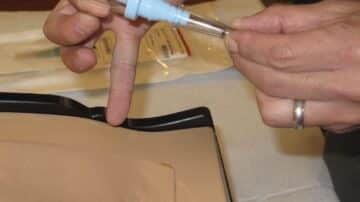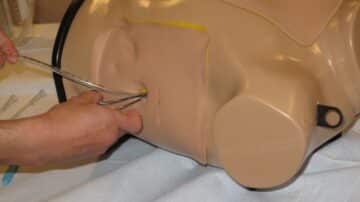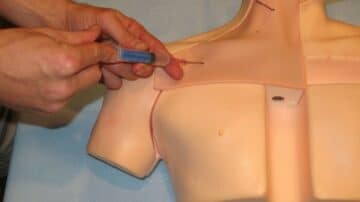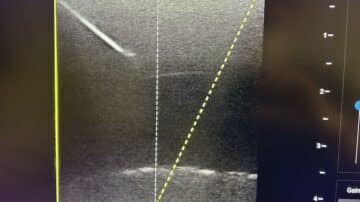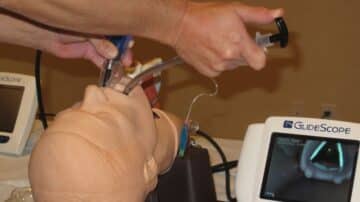The number of bacterial meningitis cases is over 1.2 million each year while 1 in 10 people who have it may die from the infection despite receiving treatment. Bacterial meningitis is an extremely serious and life-threatening condition requiring prompt diagnosis.…
Read MoreThe insertion of chest tubes or tube thoracostomy is an effective way to drain blood, air, pus, and other fluids from the thorax to address pleural effusion. It is part of postoperative care for cardiothoracic surgeries which involve the lungs,…
Read MoreChest drainage is an ancient medical procedure that’s been used to treat infections, effusions, pneumothorax, and thoracic trauma. In the modern medical world, chest tubes are a ubiquitous tool for managing pneumothorax, pleural air leaks, traumatic hemothorax, infected pleural effusions,…
Read MoreCentral line placement is a common medical procedure that many healthcare professionals perform. Around 8% of hospitalized patients need central line access while over five million central venous catheters are inserted by medical professionals in the United States each year.…
Read MoreIn the United States, about 8 million catheters are inserted into arteries each year. From this group, a significant number are performed at teaching institutions by residents physicians and at other hospitals usually in the ICU, the OR and occasionally…
Read MorePleural effusion is a common yet complex medical condition that requires tailored and multidisciplinary treatment. Despite being a common disease, its cause remains unknown in at least 20% of patients even after diagnostic workups. Fortunately, pleural fluid tests have improved…
Read MorePericardiocentesis Pericardiocentesis or a pericardial tap is a life-saving invasive medical procedure that physicians perform to eliminate a pericardial effusion, built-up fluid in the pericardium or the pericardial sac. This double-walled fibrous sac protects the heart and big vessels while…
Read MoreCritical emergency skills are an important tool in a healthcare provider’s arsenal. They must be able to safely perform emergency procedures to save lives when faced with a critical situation. However, once they finish their studies and training, many physicians…
Read MoreUltrasound-guided paracentesis is a common hospital procedure that medical professionals perform to drain ascites in patients with advanced cirrhosis. It has a low bleeding risk and is used for diagnostic or therapeutic purposes. Although paracentesis is generally a safe procedure,…
Read MoreLumbar punctures (LPs) are a common medical procedure that is used to collect cerebrospinal fluid (CSF) to diagnose and manage neurological illnesses. Here, we delve into the results of a new study on the safety of LPs for patients undergoing…
Read MoreConditions like congestive heart failure, pneumonia, cancer, and lupus can cause excess fluid to accumulate in the pleural space or area between the lungs and chest wall. To aspirate fluid from a pleural effusion, a medical procedure known as thoracentesis…
Read MoreVideolaryngoscopy has quickly become a popular method for airway management because it provides better visuals of the glottis. Failed intubations have decreased since more clinicians have begun to rely on videolaryngoscopy and the greater visibility it provides. Awake videolaryngoscopy is…
Read MoreIntraosseous lines are commonly associated with decreased return of spontaneous circulation or ROSC rates compared to peripheral IV access. Intraosseous lines have also been linked to decreased survival after out-of-hospital and in-hospital cases of cardiac arrest in comparison to IV…
Read MoreTraditionally, traumatic hemothorax treatment called for the insertion of a 36-French (36F) to 40F large-bore chest tube (CT). In this article, we’ll delve into a study that shows how 14F percutaneous catheters (P-CATs or PCs) or pigtail catheters have equal…
Read MoreCirrhosis refers to a chronic liver disease that causes the liver’s normal architecture to change. It leads to scarring, the formation of fibrous tissue, and fluid (ascites) in the abdomen. Some cases may require invasive hospital procedures. Ascites is cirrhosis’…
Read MoreCategories
- ACLS (1)
- Arterial line (33)
- Cardiovascular diseases (77)
- Central line (55)
- Chest Tube (39)
- Dermatology (4)
- Emergency Procedures (138)
- Endocrinology (6)
- Endotracheal Intubation (36)
- Events (24)
- FAST Exam (12)
- Featured (112)
- Featured Procedure (42)
- Gastrointestinal diseases (32)
- Ginecology (3)
- Glidescope Intubation (21)
- Hematology (33)
- Hospital Procedures (85)
- Infections (32)
- Intraosseous line (8)
- King Tube (27)
- Laryngeal Mask Airway (18)
- Lumbar Puncture (36)
- Mechanical Ventilation (34)
- Medical General (95)
- medical procedures (258)
- Needle Decompression (6)
- Nephrology (11)
- Neurological diseases (12)
- Oncology (4)
- Paracentesis (32)
- Pericardiocentesis (3)
- Procedural Sedation (19)
- Respiratory diseases (85)
- RUSH Exam (8)
- Thoracentesis (37)
- Traumatology (24)
- Travel (27)
- Ultrasound-Guided Peripheral IV (13)


